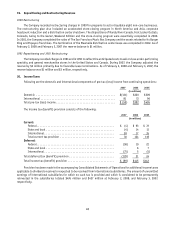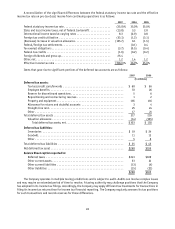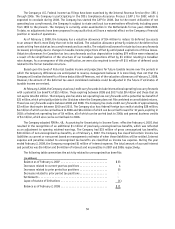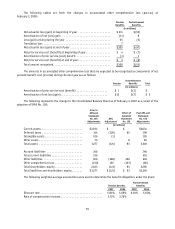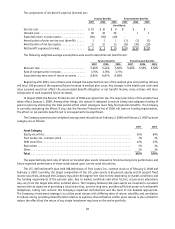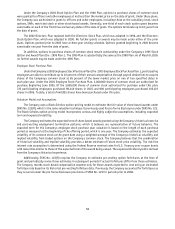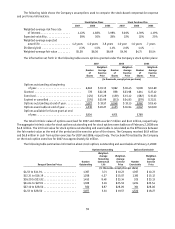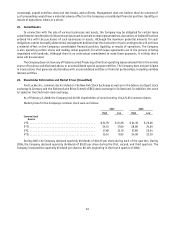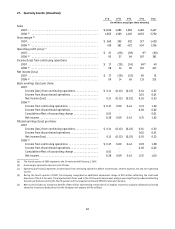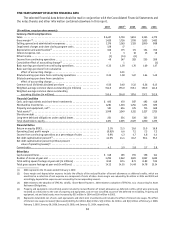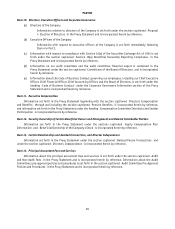Foot Locker 2007 Annual Report Download - page 74
Download and view the complete annual report
Please find page 74 of the 2007 Foot Locker annual report below. You can navigate through the pages in the report by either clicking on the pages listed below, or by using the keyword search tool below to find specific information within the annual report.58
Under the Company’s 2003 Stock Option Plan and the 1998 Plan, options to purchase shares of common stock
were granted to officers and other employees at not less than the market price on the date of grant. Under these plans,
the Company was authorized to grant to officers and other employees, including those at the subsidiary level, stock
options, SARs, restricted stock or other stock-based awards. Generally, one-third of each stock option grant becomes
exercisable on each of the first three anniversary dates of the date of grant. The options terminate up to 10 years from
the date of grant.
The 2002 Directors’ Plan replaced both the Directors’ Stock Plan, which was adopted in 1996, and the Directors’
Stock Option Plan, which was adopted in 2000. No further grants or awards may be made under either of the prior
plans. Options granted prior to 2003 have a three-year vesting schedule. Options granted beginning in 2003 become
exercisable one year from the date of grant.
In addition, options to purchase shares of common stock remain outstanding under the Company’s 1995 Stock
Option and Award Plan (the “1995 Plan”). The 1995 Plan is substantially the same as the 1998 Plan. As of March 8, 2005
no further awards may be made under the 1995 Plan.
Employee Stock Purchase Plan
Under the Company’s 2003 Employees Stock Purchase Plan (the “2003 Employee Stock Purchase Plan”), participating
employees are able to contribute up to 10 percent of their annual compensation through payroll deductions to acquire
shares of the Company’s common stock at 85 percent of the lower market price on one of two specified dates in
each plan year. Under the 2003 Employee Stock Purchase Plan, 3,000,000 shares of common stock are authorized for
purchase beginning June 2005. Of the 3,000,000 shares of common stock authorized for purchase under this plan,
723 participating employees purchased 98,449 shares in 2007, and 806 participating employees purchased 105,123
shares in 2006. To date, a total of 440,925 shares have been purchased under this plan.
Valuation Model and Assumptions
The Company uses a Black-Scholes option-pricing model to estimate the fair value of share-based awards under
SFAS No. 123(R), which is the same valuation technique it previously used for pro forma disclosures under SFAS No. 123.
The Black-Scholes option-pricing model incorporates various and highly subjective assumptions, including expected
term and expected volatility.
The Company estimates the expected term of share-based awards granted using the Company’s historical exercise
and post-vesting employment termination patterns, which it believes are representative of future behavior. The
expected term for the Company’s employee stock purchase plan valuation is based on the length of each purchase
period as measured at the beginning of the offering period, which is one year. The Company estimates the expected
volatility of its common stock at the grant date using a weighted-average of the Company’s historical volatility and
implied volatility from traded options on the Company’s common stock. The Company believes that the combination
of historical volatility and implied volatility provides a better estimate of future stock price volatility. The risk-free
interest rate assumption is determined using the Federal Reserve nominal rates for U.S. Treasury zero-coupon bonds
with maturities similar to those of the expected term of the award being valued. The expected dividend yield is derived
from the Company’s historical experience.
Additionally, SFAS No. 123(R) requires the Company to estimate pre-vesting option forfeitures at the time of
grant and periodically revise those estimates in subsequent periods if actual forfeitures differ from those estimates.
The Company records stock-based compensation expense only for those awards expected to vest using an estimated
forfeiture rate based on its historical pre-vesting forfeiture data. Previously, the Company accounted for forfeitures as
they occurred under the pro forma disclosure provisions of SFAS No. 123 for periods prior to 2006.


